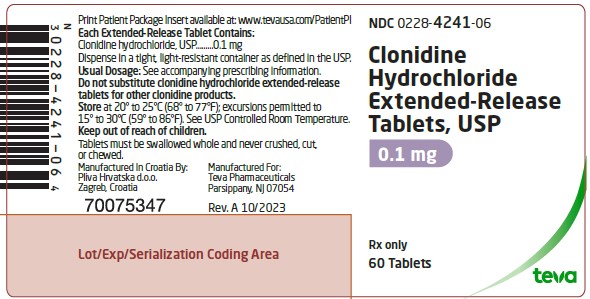Drug Catalog - Product Detail
CLONIDINE HCl ER TB 0.1MG 60
| NDC | Mfr | Size | Str | Form |
|---|---|---|---|---|
| 00228-4241-06 | ACTAVIS PHARMA | 60 | 0.1MG | TABLET |
PACKAGE FILES






Generic Name
CLONIDINE HYDROCHLORIDE
Substance Name
CLONIDINE HYDROCHLORIDE
Product Type
HUMAN PRESCRIPTION DRUG
Route
ORAL
Application Number
ANDA203320
Description
11 DESCRIPTION Clonidine hydrochloride extended-release is a centrally acting alpha 2 -adrenergic agonist available as 0.1 mg extended-release tablets for oral administration. Each 0.1 mg tablet is equivalent to 0.087 mg of the free base. The inactive ingredients are colloidal silicon dioxide, hydroxyethyl cellulose, hydroxypropyl cellulose, magnesium stearate, microcrystalline cellulose, red iron oxide, sodium lauryl sulfate and titanium dioxide. The formulation is designed to delay the absorption of active drug in order to decrease peak to trough plasma concentration differences. Clonidine hydrochloride, USP is an imidazoline derivative and exists as a mesomeric compound. The chemical name is 2-(2,6-dichlorophenylamino)-2-imidazoline hydrochloride. The following is the structural formula: Clonidine hydrochloride, USP is an odorless, bitter, white, crystalline substance soluble in water and alcohol. Product meets Dissolution Test 4. bceb3bbb-figure-03
How Supplied
16 HOW SUPPLIED/STORAGE AND HANDLING Clonidine Hydrochloride Extended-Release Tablets, USP are supplied as follows: 0.1 mg — Each pink, round, unscored tablet debossed with on one side and 241 on the other side contains 0.1 mg of clonidine hydrochloride, USP. Tablets are supplied in bottles of 60 (NDC 0228-4241-06). Store at 20° to 25°C (68° to 77°F); excursions permitted to 15° to 30°C (59° to 86°F). See USP Controlled Room Temperature. Brands listed are the trademarks of their respective owners. Dispense in a tight, light-resistant container as defined in the USP. bceb3bbb-figure-05
Indications & Usage
1 INDICATIONS AND USAGE Clonidine hydrochloride extended-release tablets are indicated for the treatment of attention deficit hyperactivity disorder (ADHD) as monotherapy and as adjunctive therapy to stimulant medications [see Clinical Studies (14) ] . Clonidine hydrochloride extended-release tablets are a centrally acting alpha 2 -adrenergic agonist indicated for the treatment of attention deficit hyperactivity disorder (ADHD) as monotherapy or as adjunctive therapy to stimulant medications. ( 1 )
Dosage and Administration
2 DOSAGE AND ADMINISTRATION Start with one 0.1 mg tablet at bedtime for one week. Increase daily dosage in increments of 0.1 mg/day at weekly intervals until the desired response is achieved. Take twice a day, with either an equal or higher split dosage being given at bedtime, as depicted below ( 2.2 ) Total Daily Dose Morning Dose Bedtime Dose 0.1 mg/day 0.1 mg 0.2 mg/day 0.1 mg 0.1 mg 0.3 mg/day 0.1 mg 0.2 mg 0.4 mg/day 0.2 mg 0.2 mg Do not crush, chew or break tablet before swallowing. ( 2.1 ) Do not substitute for other clonidine products on a mg-per-mg basis, because of differing pharmacokinetic profiles. ( 2.1 ) When discontinuing, taper the dose in decrements of no more than 0.1 mg every 3 to 7 days to avoid rebound hypertension. ( 2.3 ) 2.1 General Dosing Information Clonidine hydrochloride is an extended-release tablet to be taken orally with or without food. Swallow tablets whole. Do not crush, chew, or break tablets because this will increase the rate of clonidine release. Due to the lack of controlled clinical trial data and differing pharmacokinetic profiles, substitution of clonidine hydrochloride extended-release tablets for other clonidine products on a mg-per-mg basis is not recommended [see Clinical Pharmacology (12.3) ] . 2.2 Dose Selection The dose of clonidine hydrochloride extended-release tablets administered either as monotherapy or as adjunctive therapy to a psychostimulant, should be individualized according to the therapeutic needs and response of the patient. Dosing should be initiated with one 0.1 mg tablet at bedtime, and the daily dosage should be adjusted in increments of 0.1 mg/day at weekly intervals until the desired response is achieved. Doses should be taken twice a day, with either an equal or higher split dosage being given at bedtime (see Table 1). Table 1 Clonidine Hydrochloride Extended-Release Tablets Dosing Guidance Total Daily Dose Morning Dose Bedtime Dose 0.1 mg/day 0.1 mg 0.2 mg/day 0.1 mg 0.1 mg 0.3 mg/day 0.1 mg 0.2 mg 0.4 mg/day 0.2 mg 0.2 mg Doses of clonidine hydrochloride extended-release tablets higher than 0.4 mg/day (0.2 mg twice daily) were not evaluated in clinical trials for ADHD and are not recommended. When a clonidine hydrochloride extended-release tablet is being added-on to a psychostimulant, the dose of the psychostimulant can be adjusted depending on the patient's response to clonidine hydrochloride extended-release tablets. 2.3 Discontinuation When discontinuing clonidine hydrochloride extended-release tablets, the total daily dose should be tapered in decrements of no more than 0.1 mg every 3 to 7 days to avoid rebound hypertension [see Warnings and Precautions (5.3) ] . 2.4 Missed Doses If patients miss a dose of clonidine hydrochloride extended-release tablets, they should skip that dose and take the next dose as scheduled. Do not take more than the prescribed total daily amount of clonidine hydrochloride extended-release tablets in any 24-hour period.
